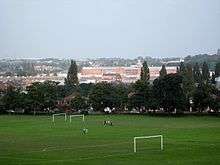HM Prison Wakefield
 HM Prison Wakefield dominates the skyline of Wakefield. | |
| Location | Wakefield, West Yorkshire, England |
|---|---|
| Security class | Adult Male/Category A |
| Population | 751 (as of November 2007) |
| Opened | 1594 |
| Managed by | HM Prison Services |
| Governor | Susan Howard |
Her Majesty's Prison Wakefield is a Category A men's prison, located in Wakefield, West Yorkshire, England. The prison is operated by Her Majesty's Prison Service, and is the largest high-security prison in the United Kingdom (and western Europe). The prison has been nicknamed the "Monster Mansion" due to the large number of high-profile, high-risk sex offenders and murderers held there.[1][2]
History


Wakefield Prison was originally built as a house of correction in 1594. Most of the current prison buildings date from Victorian times. The current prison was designated a ‘dispersal' prison in 1966 (the longest of the remaining original group).
"Here We Go 'Round the Mulberry Bush"
The exercise yard at Wakefield has a mulberry tree, around which female inmates used to exercise. This has been linked to the nursery rhyme "Here We Go Round the Mulberry Bush" by the erstwhile prison governor, RS Duncan in his book 'Here we go round the mulberry bush': The House of Correction 1595 / HM Prison Wakefield 1995 (published by author 1994). This origin of the song is also propounded on the prison's website. There is no corroborative evidence to support this theory.
First World War
During the First World War, Wakefield Prison was used as a Home Office work camp. The ordinary criminal prisoners were removed, and the new influx were sentenced to two or more years' imprisonment for refusing to obey military orders.[3] After the closure of Dyce prison camp in October 1916, Wakefield Prison was also used to intern conscientious objectors.[4] In September 1918 a group of conscientious objectors took advantage of a slackening in the prison regime that occurred towards the end of the war, by rebelling and refusing to undertake any work.[4] They issued a list of demands for better treatment, known as the Wakefield Manifesto.[4]
Recent history
In 2001 it was announced that a new Supermax security unit was to be built at Wakefield Prison. The unit was to house the most dangerous inmates within the British prisons system, and was the first such unit of its kind to be built in the United Kingdom.[5]
In March 2004 an inspection report from Her Majesty's Chief Inspector of Prisons criticised staff at Wakefield Prison for being disrespectful to inmates. The report claimed that the prison was "over-controlled", and a third of the prison's inmates claimed to have been victimised.[6]
Present
Wakefield Prison holds approximately 600 of Britain's most dangerous people (mainly sex offenders and prisoners serving life sentences for violent crimes against women and children). Accommodation at the prison comprises single-occupancy cells with integral sanitation. All residential units have kitchens available for offenders to prepare their own meals. An Incentives and Earned Privileges system allows standard and enhanced offenders the opportunity of in-cell TV. All offenders are subject to mandatory drugs testing and there are voluntary testing arrangements, which are compulsory for all offenders employed as e.g. wing cleaners or kitchen workers.
HMP Wakefield offers a range of activities for inmates, including charity work, an accredited course in industrial cleaning, and a Braille shop where offenders convert books to Braille. The Education Department is operated by The Manchester College, and offers learning opportunities ranging from basic skills to Open University courses. Other facilities include a prison shop, gym, and multi-faith chaplaincy.
Former inmates
- Spy Klaus Fuchs, convicted of supplying information from British and American nuclear weapon research to the USSR, served nine years and four months of his fourteen-year term at Wakefield, between 1951 and 1959.
- Child murderer and sex offender Ian Huntley was held at Wakefield until 23 January 2008 when he was moved to HMP Frankland.[7]
- Momcilo Krajisnik
- Radislav Krstic
- Serial killer Dr. Harold Shipman committed suicide at Wakefield Prison in 2004. Shipman had been on round-the-clock suicide watch at two previous prisons, but such 'special measures' had not been deemed necessary after his transfer to Wakefield.[8]
- Ian Watkins, transferred to Long Lartin.[9]
- Michael Sams[10]
- Robert Black, transferred to HMP Maghaberry in Northern Ireland, where he died in 2016.[11]
References
- ↑ Thompson, Tony (27 April 2003). "The caged misery of Britain's real 'Hannibal the Cannibal'". The Observer. London. Retrieved 13 July 2011.
- ↑ "A long way to go at 'monster mansion'". Wakefield Express. Wakefield. 6 October 2005. Retrieved 14 July 2011.
- ↑ Webb, Simon (31 January 2016). British Concentration Camps: A Brief History from 1900-1975. Oxford, UK: Casemate Publishers. pp. 58–60. ISBN 9781473846326.
- 1 2 3 Kramar, Ann (30 November 2014). Conscientious Objectors of the First World War: A Determined Resistance. Barnsley, UK: Pen and Sword. ISBN 9781473842441.
- ↑ "New unit for killer inmates". bbc.co.uk. 23 January 2001. Retrieved 1 February 2009.
- ↑ "Staff 'disrespectful' to inmates". bbc.co.uk. 25 March 2004. Retrieved 1 February 2009.
- ↑ "Soham killer treated for overdose". bbc.co.uk. 5 September 2006. Retrieved 1 February 2009.
- ↑ "Shipman suicide 'not preventable'". bbc.co.uk. 25 August 2005. Retrieved 1 February 2009.
- ↑ "Ian Watkins moved to same prison as child killer Ian Huntley". wales online. 24 January 2014. Retrieved 24 January 2014.
- ↑ https://web.archive.org/web/20050316163821/http://www.telegraph.co.uk:80/htmlContent.jhtml?html=/archive/1997/02/14/nsams14.html
- ↑ "Child killer Robert Black dies in prison". The Herald. Scotland. 12 January 2016. Retrieved 13 January 2016.
External links
Coordinates: 53°40′57″N 1°30′33″W / 53.68250°N 1.50917°W
| Wikimedia Commons has media related to HM Prison Wakefield. |